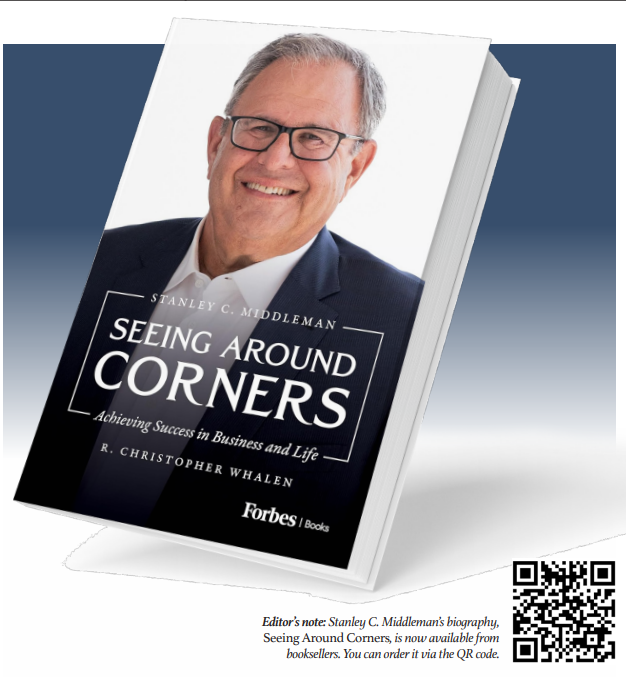Stanley C. Middleman serves as the President and CEO of Freedom Mortgage Corporation, one of the largest and fastest-growing independent mortgage companies in the country. He is a nationally recognized business strategist, investor, and philanthropist with over 30 years of experience in the mortgage banking industry. Since founding Freedom Mortgage in 1990, Middleman has grown the company into one of the nation’s largest non-bank mortgage lenders/servicers and a top VA and FHA (government-insured) lender.
Middleman is an active member of the MBA, where he serves on the MBA Board of Directors and previously on the MBA Residential Board of Governors. He has also served on numerous advisory boards in the mortgage industry, including the boards of Freddie Mac, Fannie Mae, and Ellie Mae. He is currently a member of the Housing Policy Executive Council.
At Freedom, Middleman has prioritized philanthropic efforts across multiple fronts. Established in 2013, Freedom Cares provides Freedom Mortgage employees, family members, friends, and customers with information on activities that benefit local communities, as well as active duty, reserve, and veterans of all branches of the military. Freedom Cares also encourages employees to take action for the betterment of their communities.
Since 2017, Freedom Mortgage has focused on four main philanthropic campaigns. The company runs a Holiday Toy Drive throughout the month of November. In early December, employees will volunteer at “Angel Tree Shops” at some Salvation Army locations to help parents and caretakers shop for gifts.
- 2012-Toy Drive began
- 2013-Rucksacks to Backpacks began
- 2015-Food collection drive began
- 2017-Project Gratitude began
As a top VA lender, Middleman and Freedom are focused on supporting nonprofits that benefit veterans and active-duty service members, including relationships with the USO, Salvation Army, and Home for Our Troops. The company also supports MBA’s Opens Doors Foundation.
Middleman and his family also established the Middleman Family Pavilion, the second hospital for the Children’s Hospital of Philadelphia, to serve those in the suburbs. Middleman also supports Temple (his alma mater), the Kimmel Center in Philly and the Philadelphia Art Museum.
Q: Tell me about how you first started in the industry and what put you on the path that has taken you along this professional road to where you are now.
Well, I needed to make a living, right? So, when you need a job, you get up and you go do something. I had been selling annuities, which is an insurance investment vehicle. Interest rates were high, and it was easy to sell investments when you were giving a 15% return. But as interest rates began to come back down in the early ‘80s, it became increasingly more difficult to sell annuities as an investment.
I decided that the inverse relationship of investing was lending or borrowing. I initially got involved in mortgages as a way to fund annuities because people’s values of their homes had gone way up.
So, they had an opportunity to borrow money out of their homes to find money to invest, because the hard part about selling investments is finding people with money to invest.
What I discovered was that it was easier to sell the mortgage coming off high interest rates than it was to sell the investment, and the investment was costing me mortgage sales. I ended up making more money on the mortgages than I was making on the investments. And voila, there I was.
Q: Could you talk about some of the biggest shifts that you’ve experienced in the industry during your time in the industry?
I’ve seen a lot of change. When we started in mortgage, we had rooms full of typists, and we had to type verifications of employment and verifications of income, send them to the employer, and get the bank references from the bank and get them back. We had typewriters, and we used carbon paper. It was a different world.
In 1993, the largest servicer of residential mortgages was the General Electric Capital Company. They were the first hundred-billion-dollar servicer. They were located in Cherry Hill, New Jersey, and they took up three big office buildings. Today, Freedom Mortgage services $650 billion worth of loans, and we do it with about 3,000 people.
It’s very interesting to have been able to bear witness to the evolution of an industry that grew through technology, wisdom, and major advances. I’ve seen the savings and loan industry, which was the majority of all mortgage origination and servicing, but it was a fractured industry where virtually nobody had more than a percent or two of all the servicing and origination. It was a very localized business, to the point where it turned over to commercial banks and mortgage brokers, and then mortgage bankers, and today what we call nonbanks.
We’ve seen a lot of changes over the years as we saw the birth and growth of an industry that has evolved enormously. I’ve been fortunate enough to have a front-row seat and even sometimes to be a participant in those changes.
Q: The title of your new biography, Seeing Around Corners, seems to speak to what we’re talking about—the perspective of seeing and anticipating change. How did you settle on that title and what does it mean to you?
Everything is interconnected and nobody ever really has an original thought, right? All great ideas are birthed by other ideas that came before them, and you can help those ideas evolve or make connections between ideas that can lead to new ideas. I was contemplating the name “Connecting the Dots” for the book, which I thought would’ve been a good way to describe what we do, which is taking existing activities and working around them.
I was sitting in the jacuzzi with a neighbor of mine who has since passed, a good friend, and he was very flattering to me. He said, “So many people spend their time living in what has happened and making decisions based on what has happened. And you seem to be making decisions based on what will happen.
There’s very few people that can see around corners to do that.” I was very flattered by that. It was Dr. Bruce Levine, and he was a terrific guy so I thought it was fitting to use that as the title of the book.
Q: To what do you attribute that quality he saw in you? Do you think it’s just purely the experience of having been in this industry for all this time or is there more to it?
If you go back to that ‘80s timeframe when I first started originating loans and sold them to savings and loans, I used to take boxes of loans to Camden from my home in South Jersey, and I would meet with the president of the bank and he and I would chit-chat. I didn’t know anything about lending, but he shared with me about the real estate cycle. Shortly after that, he was a victim of the savings and loan disaster, which was very much a part of the cycle that he described to me.
As I got to watch this cycle thing up close, I started to understand that there’s a certain tidal nature to the economy. If you’re not sensitive and aware of your surroundings, there’s so much that you miss.
I was fortunate enough to be sensitive to these happenings in the world and put together the fact that they weren’t happening in a vacuum. They were happening in the context of a broader world.
Q: What role has mentorship played in your life?
I never really worked for any of the people who were mentors to me as an employer or employee, but I had to work hard to learn what I needed to learn. I like to be open and share all I can with everybody I can because most people don’t do anything with what you tell them anyway.
Other people don’t behave that way, they hoard information and don’t think that they should share information because they’re afraid of what somebody else might do with it. I’m not sure that any of that works that way. You have to use good sense, and certain things should not be public knowledge, but you shouldn’t hoard information just because you’re afraid somebody might learn something.
I like to tell people what I’m doing and what I’m thinking because I want to know if I’m crazy. One of the ways that you learn is by talking about things that you might do and seeing how people react to them. “Yeah, I think that’s a good idea,” or “Boy, that’s silly. Why would you do that?” You need to create a dialogue that allows for a give-and-take, and you can’t get a give-and-take dialogue by taking and not giving. If you’re not prepared to share information, you’re probably not going to receive information.
Q: Throughout your career, what have you learned about hiring and recognizing the potential for good leadership?
My biggest problem when I opened my business, and I was in business for a year, was that I didn’t have any five-year guys. Nobody saw the world the way I saw the world, and I didn’t have everybody pulling the boat in the same direction I wanted to go, so, we weren’t very efficient in our energy expenditure. After being in business for five years, my biggest problem was not having any 10-year guys.
And my biggest problem at the end of 10 years was, I didn’t have any 15-year guys. So, I was interested in building longevity and getting people aligned with my perspective, and that’s very difficult to do.
I wasn’t as interested in the thoroughbred as I was in the plow horse. I wanted somebody who was going to work their tail off and learn with me, not drag me along, but push along with me. I think that’s kind of something that comes with being a founder, where you need to create a culture that’s one of loyalty, dedication, and determination.
Those were the traits I was looking for when I first started. We had built this culture where it was us against the world.
We were going to do extraordinary things in different ways that made us special. There were no nonbanks [at the time]. There were big banks, and there were savings and loans, but we were talking about institutional places that were predominant rather than independent small businesses that were growing. We were growing and having a lot of success, but we were insular. We thought we saw the world differently.
What made us special was that we didn’t act or behave like a bank. We didn’t behave like a super-corporation that came into the mortgage business as a spinoff of a larger business like GM, Ford, or GE Capital.
One large company after the next came into mortgage finance for a variety of reasons, where it was just a sideline. On the other hand, we were scratching and clawing and making our way along every day. I had to hire people with a different pedigree.
As we gained more capital, more money, more success, and more liquidity, we were able to do different things. I was able to hire people with different talents, and then we slowly added talent to meet specific needs. So, we went from cultural hires—people who could be of the same ilk and see things the same way—to people that came from different [backgrounds] that brought additional skills. Then, we started hiring specific skill sets, to enhance the quality of the business, and then we morphed into just hiring smarter people with better educations and bigger resumes and more experience.
Q: Any final thoughts about what you hope people take away from the book?
Well, the book was originally intended to share ideas about cycles and how you can create a certain level of predictability. But one of the things I think is important to come from the book is that arrogance has no place in business. You need to be sensitive and aware of not only your surroundings and your environment but of the people in those surroundings.
You have to know that you have a responsibility to your stakeholders, whether they’re your customers, your employees, your partners, or your associates, and your job is to grow with them. The way that that happens is you take responsibility for what goes wrong, not blaming them for what goes wrong.
You can’t be arrogant, you can’t be bureaucratic and expect to be successful. The more that you do, the greater success that you can have, and the more responsibility you take for your actions, the more success that you’ll have and the more serious you’ll be about managing the outcome. If you don’t take responsibility, you’re going to look for somebody to blame. And it’s not about whose fault it is; it’s about did you get where you’re going?
You’re only going to get there if you’re smart enough to know that you need people and that you need to help them achieve their goals as well as yours.







